
Question Number 2722 by prakash jain last updated on 25/Nov/15
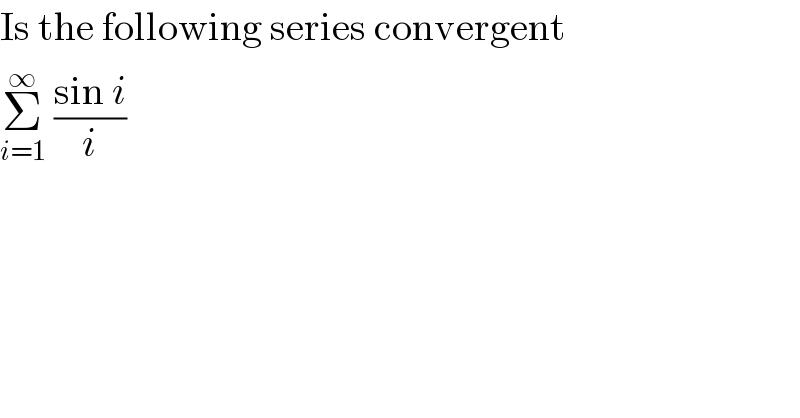
$$\mathrm{Is}\:\mathrm{the}\:\mathrm{following}\:\mathrm{series}\:\mathrm{convergent} \\ $$$$\underset{{i}=\mathrm{1}} {\overset{\infty} {\sum}}\:\frac{\mathrm{sin}\:{i}}{{i}} \\ $$
Answered by Filup last updated on 25/Nov/15

$$\mathrm{no} \\ $$$$ \\ $$$$\mathrm{for}\:{x}\in\left(−\infty,\infty\right) \\ $$$$−\mathrm{1}\leqslant{sin}\:{x}\leqslant\mathrm{1} \\ $$
Answered by prakash jain last updated on 25/Nov/15
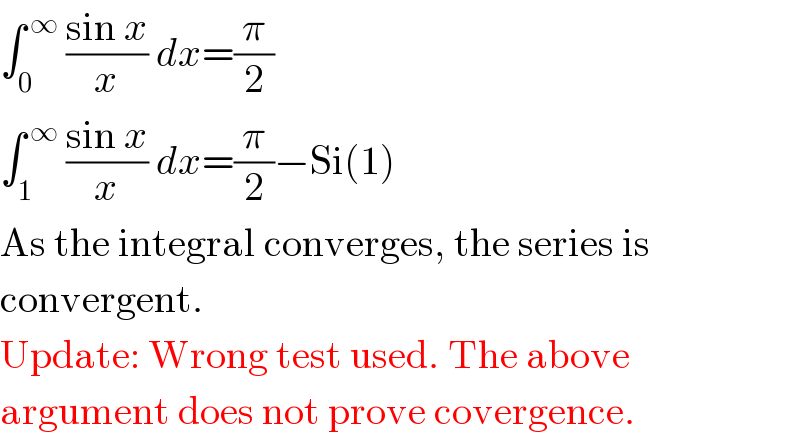
$$\int_{\mathrm{0}} ^{\:\infty} \:\frac{\mathrm{sin}\:{x}}{{x}}\:{dx}=\frac{\pi}{\mathrm{2}} \\ $$$$\int_{\mathrm{1}} ^{\:\infty} \:\frac{\mathrm{sin}\:{x}}{{x}}\:{dx}=\frac{\pi}{\mathrm{2}}−\mathrm{Si}\left(\mathrm{1}\right) \\ $$$$\mathrm{As}\:\mathrm{the}\:\mathrm{integral}\:\mathrm{converges},\:\mathrm{the}\:\mathrm{series}\:\mathrm{is} \\ $$$$\mathrm{convergent}. \\ $$$$\mathrm{Update}:\:\mathrm{Wrong}\:\mathrm{test}\:\mathrm{used}.\:\mathrm{The}\:\mathrm{above} \\ $$$$\mathrm{argument}\:\mathrm{does}\:\mathrm{not}\:\mathrm{prove}\:\mathrm{covergence}. \\ $$
Commented by Yozzi last updated on 26/Nov/15
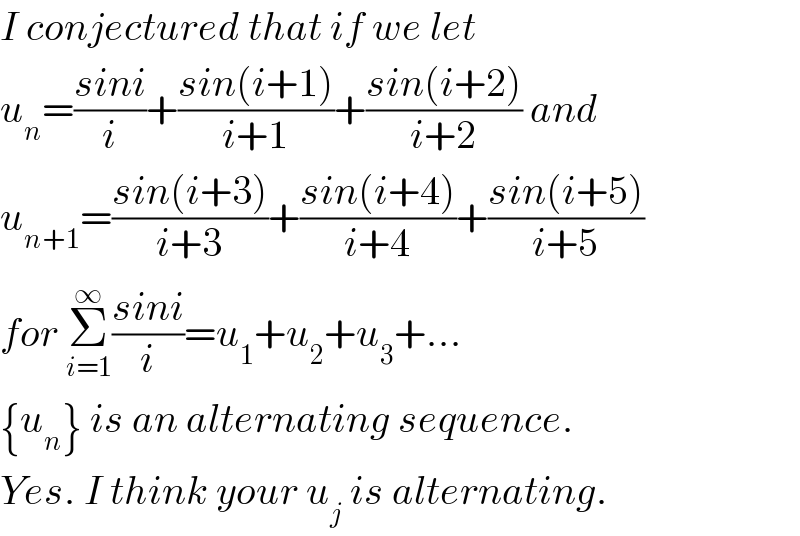
$${I}\:{conjectured}\:{that}\:{if}\:{we}\:{let} \\ $$$${u}_{{n}} =\frac{{sini}}{{i}}+\frac{{sin}\left({i}+\mathrm{1}\right)}{{i}+\mathrm{1}}+\frac{{sin}\left({i}+\mathrm{2}\right)}{{i}+\mathrm{2}}\:{and}\: \\ $$$${u}_{{n}+\mathrm{1}} =\frac{{sin}\left({i}+\mathrm{3}\right)}{{i}+\mathrm{3}}+\frac{{sin}\left({i}+\mathrm{4}\right)}{{i}+\mathrm{4}}+\frac{{sin}\left({i}+\mathrm{5}\right)}{{i}+\mathrm{5}} \\ $$$${for}\:\underset{{i}=\mathrm{1}} {\overset{\infty} {\sum}}\frac{{sini}}{{i}}={u}_{\mathrm{1}} +{u}_{\mathrm{2}} +{u}_{\mathrm{3}} +... \\ $$$$\left\{{u}_{{n}} \right\}\:{is}\:{an}\:{alternating}\:{sequence}. \\ $$$${Yes}.\:{I}\:{think}\:{your}\:{u}_{{j}} \:{is}\:{alternating}. \\ $$
Commented by prakash jain last updated on 26/Nov/15
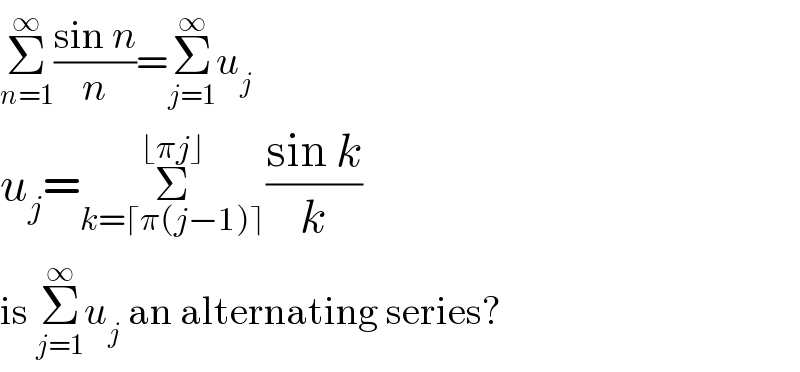
$$\underset{{n}=\mathrm{1}} {\overset{\infty} {\sum}}\frac{\mathrm{sin}\:{n}}{{n}}=\underset{{j}=\mathrm{1}} {\overset{\infty} {\sum}}{u}_{{j}} \\ $$$${u}_{{j}} =\underset{{k}=\lceil\pi\left({j}−\mathrm{1}\right)\rceil} {\overset{\lfloor\pi{j}\rfloor} {\sum}}\frac{\mathrm{sin}\:{k}}{{k}} \\ $$$$\mathrm{is}\:\underset{{j}=\mathrm{1}} {\overset{\infty} {\sum}}{u}_{{j}} \:\mathrm{an}\:\mathrm{alternating}\:\mathrm{series}? \\ $$
Commented by Filup last updated on 25/Nov/15

$${My}\:{mistake}.\:\mathrm{I}\:\mathrm{Was}\:\mathrm{thinking} \\ $$$$\mathrm{incorrectly} \\ $$$$\mathrm{i}\:\mathrm{was}\:\mathrm{thinking}\:\mathrm{of}\:\Sigma\left(\mathrm{sin}\:{x}\right) \\ $$
Commented by Yozzi last updated on 25/Nov/15

$${f}\left({x}\right)=\frac{{sinx}}{{x}}\:{is}\:{not}\:{a}\:{positive},{monotonically} \\ $$$${decreasing}\:{function}\:\forall{x}\in\left[\mathrm{1},\infty\right)\:{to} \\ $$$${use}\:{the}\:{integral}\:{test}. \\ $$
Commented by prakash jain last updated on 25/Nov/15

$$\mathrm{Ok}.\:\mathrm{You}\:\mathrm{are}\:\mathrm{right}. \\ $$$$\mathrm{How}\:\mathrm{to}\:\mathrm{prove}\:\mathrm{that}\:\underset{{i}=\mathrm{1}} {\overset{\infty} {\sum}}\mathrm{sin}\left({x}\right)/{x}\:\mathrm{is}\:\mathrm{convergent}? \\ $$
Commented by Yozzi last updated on 25/Nov/15
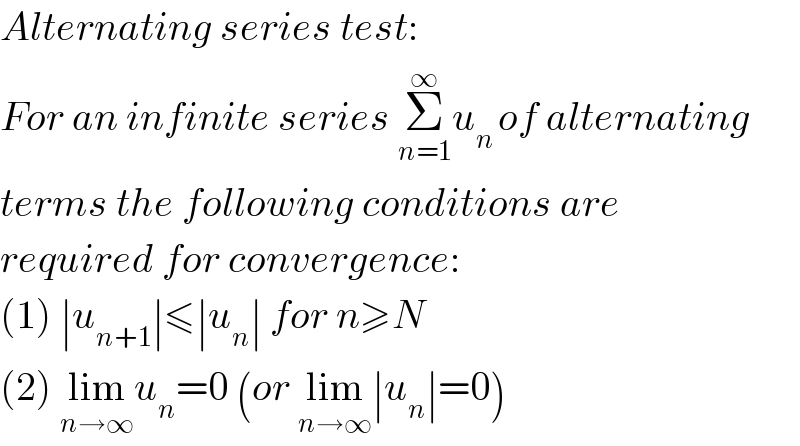
$${Alternating}\:{series}\:{test}:\: \\ $$$${For}\:{an}\:{infinite}\:{series}\:\underset{{n}=\mathrm{1}} {\overset{\infty} {\sum}}{u}_{{n}\:} {of}\:{alternating} \\ $$$${terms}\:{the}\:{following}\:{conditions}\:{are} \\ $$$${required}\:{for}\:{convergence}: \\ $$$$\left(\mathrm{1}\right)\:\mid{u}_{{n}+\mathrm{1}} \mid\leqslant\mid{u}_{{n}} \mid\:{for}\:{n}\geqslant{N} \\ $$$$\left(\mathrm{2}\right)\:\underset{{n}\rightarrow\infty} {\mathrm{lim}}{u}_{{n}} =\mathrm{0}\:\left({or}\:\underset{{n}\rightarrow\infty} {\mathrm{lim}}\mid{u}_{{n}} \mid=\mathrm{0}\right) \\ $$
Commented by prakash jain last updated on 25/Nov/15

$$\mathrm{The}\:\mathrm{series}\:\mathrm{is}\:\mathrm{not}\:\mathrm{alternating}\:\mathrm{either}. \\ $$
Commented by Yozzi last updated on 25/Nov/15

$${true}... \\ $$
Commented by prakash jain last updated on 26/Nov/15

$$\mathrm{Based}\:\mathrm{on}\:\mathrm{your}\:\mathrm{suggestion}\:\mathrm{I}\:\mathrm{was}\:\mathrm{trying}\:\mathrm{to} \\ $$$$\mathrm{come}\:\mathrm{up}\:\mathrm{with}\:\mathrm{an}\:\mathrm{equivalent}\:\mathrm{alternating} \\ $$$$\mathrm{series}. \\ $$
Answered by Yozzi last updated on 26/Nov/15

$${Consider}\:{the}\:{series}\:{T}=\underset{{i}=\mathrm{1}} {\overset{\infty} {\sum}}\frac{{sinix}}{{i}}\:\left({x}\neq\pm\pi\right). \\ $$$${Dirichlet}'{s}\:{test}\:{may}\:{be}\:{used}\:{to}\:{prove} \\ $$$${that}\:{T}\:{is}\:{uniformly}\:{convergent}\:{in} \\ $$$${an}\:{interval}\:{a}\leqslant{x}\leqslant{b}. \\ $$$${Suppose}\:{that}: \\ $$$$\left(\mathrm{1}\right)\:\left\{{a}_{{n}} \right\}\:{is}\:{a}\:{sequence}\:{of}\:{positive}\: \\ $$$${constants}\:{that}\:{are}\:{monotonic} \\ $$$${decreasing},{having}\:{a}\:{limit}\:{of}\:{zero}; \\ $$$$\left(\mathrm{2}\right)\:\exists{P}\:\left({constant}\right)\:{such}\:{that}\:{for} \\ $$$${a}\leqslant{x}\leqslant{b},\:\mid\underset{{r}=\mathrm{1}} {\overset{{n}} {\sum}}{u}_{{r}} \left({x}\right)\mid<{P}\:\:,\forall{n}>{N}. \\ $$$${Then},\:{the}\:{series}\:\underset{{n}=\mathrm{1}} {\overset{\infty} {\sum}}{a}_{{n}} {u}_{{n}} \left({x}\right)\:{is}\: \\ $$$${uniformly}\:{convergent}\:{on}\:{the}\:{interval} \\ $$$${a}\leqslant{x}\leqslant{b}. \\ $$$${Let}\:{u}_{{i}} \left({x}\right)={sinix},\:{a}_{{i}} =\frac{\mathrm{1}}{{i}}\:\:\left({i}\in\mathbb{N}\right). \\ $$$$\left(\mathrm{1}\right){For}\:{the}\:{sequence}\:\left\{{a}_{{i}} \right\},\:{its}\:{terms}\: \\ $$$${are}\:{monotonic}\:{decreasing}\:{and} \\ $$$${positive}. \\ $$$$\underset{{i}\rightarrow\infty} {\mathrm{lim}}{a}_{{i}} =\underset{{i}\rightarrow\infty} {\mathrm{lim}}\frac{\mathrm{1}}{{i}}=\frac{\mathrm{1}}{\infty}=\mathrm{0}. \\ $$$$\left(\mathrm{2}\right){Suppose}\:\mathrm{1}\leqslant{x}\leqslant\frac{\pi}{\mathrm{2}}\:{and}\:{define}\:{S}=\underset{{i}=\mathrm{1}} {\overset{{n}} {\sum}}{u}_{{i}} \left({x}\right). \\ $$$$\left({sin}\frac{{x}}{\mathrm{2}}\right){S}=\underset{{r}=\mathrm{1}} {\overset{{n}} {\sum}}{sinixsin}\frac{{x}}{\mathrm{2}}.\:\:\left(\mathrm{1}\leqslant{x}\leqslant\frac{\pi}{\mathrm{2}}\right) \\ $$$${Since}\:−\mathrm{2}{sinixsin}\frac{{x}}{\mathrm{2}}={cos}\left({i}+\frac{\mathrm{1}}{\mathrm{2}}\right){x}−{cos}\left({i}−\frac{\mathrm{1}}{\mathrm{2}}\right){x} \\ $$$$\Rightarrow{sinixsin}\frac{{x}}{\mathrm{2}}=\frac{−\mathrm{1}}{\mathrm{2}}\left\{{f}\left({r}\right)−{f}\left({r}−\mathrm{1}\right)\right\} \\ $$$${where}\:{f}\left({r}\right)={cos}\left({i}+\frac{\mathrm{1}}{\mathrm{2}}\right){x}\:\:\:\left({i}\in\mathbb{N}\right). \\ $$$$\therefore{Ssin}\frac{{x}}{\mathrm{2}}=\frac{−\mathrm{1}}{\mathrm{2}}\underset{{i}=\mathrm{1}} {\overset{{n}} {\sum}}\left\{{f}\left({r}\right)−{f}\left({r}−\mathrm{1}\right)\right\} \\ $$$$−\mathrm{2}{Ssin}\frac{{x}}{\mathrm{2}}={f}\left(\mathrm{1}\right)−{f}\left(\mathrm{0}\right)+{f}\left(\mathrm{2}\right)−{f}\left(\mathrm{1}\right)+ \\ $$$${f}\left(\mathrm{3}\right)−{f}\left(\mathrm{2}\right)+{f}\left(\mathrm{4}\right)−{f}\left(\mathrm{3}\right)+{f}\left(\mathrm{5}\right)−{f}\left(\mathrm{4}\right)+ \\ $$$$...+{f}\left({n}−\mathrm{3}\right)−{f}\left({n}−\mathrm{4}\right)+{f}\left({n}−\mathrm{2}\right)−{f}\left({n}−\mathrm{3}\right) \\ $$$$+{f}\left({n}−\mathrm{1}\right)−{f}\left({n}−\mathrm{2}\right)+{f}\left({n}\right)−{f}\left({n}−\mathrm{1}\right) \\ $$$$−\mathrm{2}{Ssin}\frac{{x}}{\mathrm{2}}={f}\left({n}\right)−{f}\left(\mathrm{0}\right) \\ $$$$\Rightarrow{S}=\frac{{f}\left(\mathrm{0}\right)−{f}\left({n}\right)}{\mathrm{2}{sin}\frac{{x}}{\mathrm{2}}} \\ $$$${S}=\frac{{cos}\frac{{x}}{\mathrm{2}}−{cos}\left({n}+\frac{\mathrm{1}}{\mathrm{2}}\right){x}}{\mathrm{2}{sin}\frac{{x}}{\mathrm{2}}} \\ $$$$−\left({cos}\left({n}+\frac{\mathrm{1}}{\mathrm{2}}\right){x}−{cos}\frac{{x}}{\mathrm{2}}\right) \\ $$$$=−\left(−\mathrm{2}{sin}\frac{{n}+\frac{\mathrm{1}}{\mathrm{2}}+\frac{\mathrm{1}}{\mathrm{2}}}{\mathrm{2}}{xsin}\frac{{n}+\frac{\mathrm{1}}{\mathrm{2}}−\frac{\mathrm{1}}{\mathrm{2}}}{\mathrm{2}}{x}\right) \\ $$$$=\mathrm{2}{sin}\frac{{n}+\mathrm{1}}{\mathrm{2}}{xsin}\frac{{nx}}{\mathrm{2}} \\ $$$$\therefore{S}=\frac{{sin}\frac{{nx}}{\mathrm{2}}{sin}\frac{{n}+\mathrm{1}}{\mathrm{2}}{x}}{{sin}\frac{{x}}{\mathrm{2}}}=\left(\frac{\mathrm{1}}{{sin}\frac{{x}}{\mathrm{2}}}\right){sin}\frac{{nx}}{\mathrm{2}}{sin}\frac{{n}+\mathrm{1}}{\mathrm{2}}{x} \\ $$$$\therefore\mid{S}\mid=\mid\frac{\mathrm{1}}{{sin}\frac{{x}}{\mathrm{2}}}{sin}\frac{{n}+\mathrm{1}}{\mathrm{2}}{sin}\frac{{nx}}{\mathrm{2}}\mid \\ $$$${Since}\:\mathrm{1}\leqslant{x}\leqslant\frac{\pi}{\mathrm{2}}\Rightarrow\frac{\mathrm{1}}{\mathrm{2}}\leqslant\frac{{x}}{\mathrm{2}}\leqslant\frac{\pi}{\mathrm{4}}\Rightarrow{sin}\frac{{x}}{\mathrm{2}}\geqslant{sin}\frac{\mathrm{1}}{\mathrm{2}}\:{for}\:\mathrm{1}\leqslant{x}\leqslant\frac{\pi}{\mathrm{2}}. \\ $$$$\therefore\mid{S}\mid={cosec}\frac{{x}}{\mathrm{2}}\mid{sin}\frac{{nx}}{\mathrm{2}}{sin}\frac{{n}+\mathrm{1}}{\mathrm{2}}{x}\mid \\ $$$${Now}\mid{sin}\frac{{u}}{\mathrm{2}}\mid<\mathrm{1}\:{for}\:\forall{u}\in\mathbb{R} \\ $$$$\Rightarrow{cosec}\frac{{x}}{\mathrm{2}}\mid{sin}\frac{{nx}}{\mathrm{2}}{sin}\frac{{n}+\mathrm{1}}{\mathrm{2}}{x}\mid<\frac{\mathrm{1}}{{sin}\frac{{x}}{\mathrm{2}}}\:\forall{n}>\mathrm{1} \\ $$$$\Rightarrow\:\mid{S}\mid<\frac{\mathrm{1}}{{sin}\frac{{x}}{\mathrm{2}}}\:\:\forall{n}>\mathrm{1}\:\left({N}=\mathrm{1}\right) \\ $$$${max}\left({sin}\frac{{x}}{\mathrm{2}}\right)\:{for}\:\mathrm{1}\leqslant{x}\leqslant\frac{\pi}{\mathrm{2}}\:{is}\:{sin}\frac{\pi}{\mathrm{4}}=\frac{\mathrm{1}}{\sqrt{\mathrm{2}}} \\ $$$$\Rightarrow\mid{S}\mid<\sqrt{\mathrm{2}}\:\Rightarrow{P}=\sqrt{\mathrm{2}}\:{for}\:\mathrm{1}\leqslant{x}\leqslant\frac{\pi}{\mathrm{2}}. \\ $$$${So},\:{conditions}\:\left(\mathrm{1}\right)\:{and}\:\left(\mathrm{2}\right)\:{are}\:{satisfied}. \\ $$$${Hence},\:{by}\:{Dirichlet}'{s}\:{test}, \\ $$$$\underset{{i}=\mathrm{1}} {\overset{\infty} {\sum}}\frac{{sinix}}{{i}}\:{is}\:{uniformly}\:{convergent} \\ $$$${in}\:{the}\:{interval}\:\mathrm{1}\leqslant{x}\leqslant\frac{\pi}{\mathrm{2}}.\:{Hence},\:{if}\:{x}=\mathrm{1}, \\ $$$$\underset{{i}=\mathrm{1}} {\overset{\infty} {\sum}}\frac{{sini}}{{i}}\:{is}\:{uniformly}\:{convergent}. \\ $$$$ \\ $$$$\left({I}\:{tried}\:{part}\:\left(\mathrm{2}\right)\:{but}\:{I}\:{know}\:{the}\:{approach}\right. \\ $$$$\left.{is}\:{incorrect}.\right) \\ $$
Commented by prakash jain last updated on 26/Nov/15
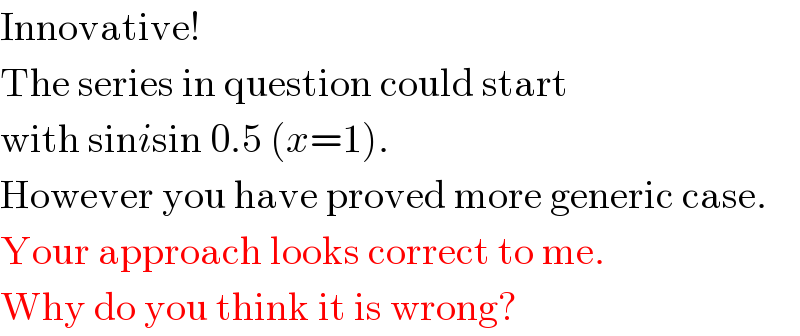
$$\mathrm{Innovative}! \\ $$$$\mathrm{The}\:\mathrm{series}\:\mathrm{in}\:\mathrm{question}\:\mathrm{could}\:\mathrm{start} \\ $$$$\mathrm{with}\:\mathrm{sin}{i}\mathrm{sin}\:\mathrm{0}.\mathrm{5}\:\left({x}=\mathrm{1}\right). \\ $$$$\mathrm{However}\:\mathrm{you}\:\mathrm{have}\:\mathrm{proved}\:\mathrm{more}\:\mathrm{generic}\:\mathrm{case}. \\ $$$$\mathrm{Your}\:\mathrm{approach}\:\mathrm{looks}\:\mathrm{correct}\:\mathrm{to}\:\mathrm{me}. \\ $$$$\mathrm{Why}\:\mathrm{do}\:\mathrm{you}\:\mathrm{think}\:\mathrm{it}\:\mathrm{is}\:\mathrm{wrong}? \\ $$
Commented by Yozzi last updated on 26/Nov/15

$${This}\:{area}\:{is}\:{new}\:{to}\:{me}\:{and}\:{I}\:{haven}'{t} \\ $$$${mastered}\:{method}\:{of}\:{proof}\:{yet}.\:{But} \\ $$$$\left.{I}'{m}\:{glad}\:{you}\:{see}\:{no}\:{issues}\:{with}\:{it}\::\right). \\ $$
